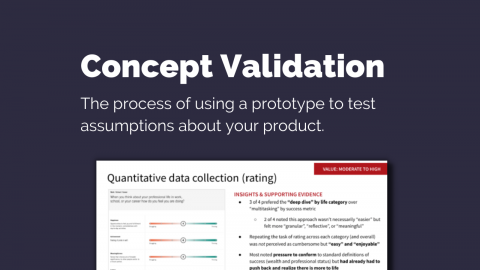The ROI of Concept Validation
Concept Validation is the next step in our effort to help you identify the potential of a user research ROI. Concept Validation research happens when there is a partially-defined, potential solution to your product that can be prototyped.
This is the second post in our series on the value of user research. Check out the first post on the ROI of discovery research, or skip ahead to the post on the ROI of usability testing.
What is Concept Validation?
Sometimes referred to as Proof of Concept testing, concept validation is the process of using a prototype to test assumptions about your product. This usually involves collecting qualitative customer research from your target audience early on in the product development process, which helps you avoid wasting resources on a product that your audience doesn’t end up wanting. Concept validation can also help you understand how you might need to pivot your product in order to be successful.
The Investment for Concept Validation:
The best way to test the validity of a concept is to create a low-fidelity representation of the idea and get it in front of potential users. This prototype should be your Minimum Viable Product, no need to spend time on visual design or polish. Develop a specific set of hypotheses (three to five if/then statements) to test. Then, schedule one-on-one interviews with potential users. These will be longer sessions (approx. 45-60 minutes) but fewer are needed because they yield more information. We typically target five to eight interviews per prototype.
The Return on Concept Validation:
The biggest gain from Concept Validation is critical feedback from a diverse set of potential users who could actually imagine themselves using your proposed solution. It quickly identifies false assumptions that are baked into the design of your concept that need to be corrected.
These assumptions tend to be more critical to the core value of the concept. It’s less about supporting features and more about foundational components related to your key value proposition or the function of your core experience. With this type of research, it’s rarely a case of the concept being 100% good to advance or 100% throw-away. Feedback received is more nuanced and usually sounds like “yes, but you need to account for …” or “no, unless I could change …”.
When To Invest in Concept Validation:
Anytime there is a new and untested product solution, it is wise to collect user feedback on it before you start to invest in the development process. This includes scenarios where there is a tangible proof-of-concept and may have skipped the Discovery Research process.
Concept Validation can also be very helpful when there are multiple possible solutions and there is internal misalignment on direction. Instead of endlessly debating the theoretical virtues of a potential solution, test it and let the users inform the decision. This type of research may also warrant subsequent, back-to-back rounds of prototyping and testing in order to correctly identify the right solution that merits advancement onto the product roadmap.
The key to keeping this investment worthwhile is to keep the wireframes low fidelity. Like, James Earl Jones reciting a sonnet; low. This means you will have to fight off the desire to add more detail and flair to your exciting, new idea. The only things that should be reflected in the prototype should be directly related to the hypotheses you are testing. Nothing more.
When ADK runs Google Ventures style Design Sprints with our partners, we usually mock up a prototype in less than a single workday.
When Not To Invest in Concept Validation:
If the core of the project is low-risk, an incremental improvement, or playing catch-up with industry standards and best practices, Concept Validation can be sacrificed to prioritize time-to-market.
Stay tuned for our third and final part of ADK’s ROI of User Research blog series, Usability Testing.
Learn More on how ADK applies the rules of concept validation.
